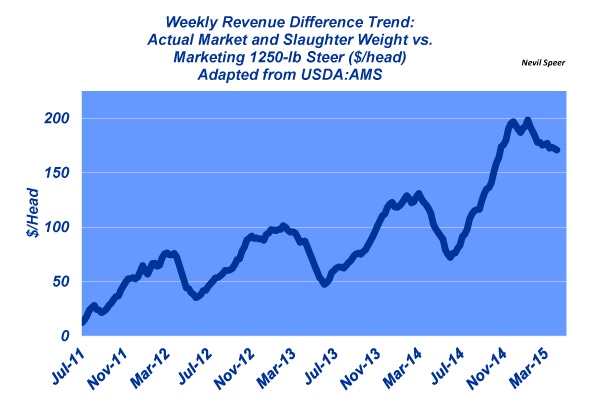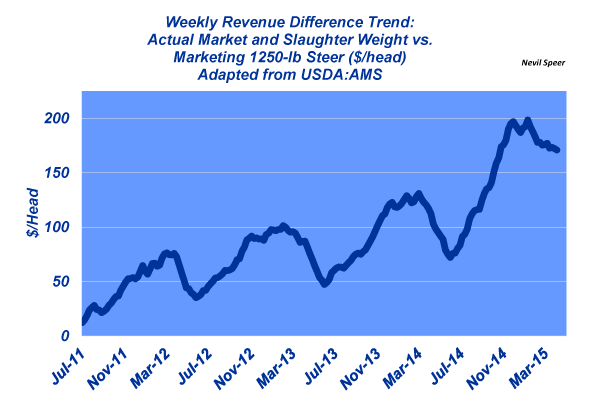Industry At A Glance: How much higher will slaughter weights go?
The potential revenue difference between a steer that can be marketed at 1,350 pounds or more versus 1,250 pounds is substantial.
April 16, 2015

Several weeks ago, Industry At A Glance focused on the feeder cattle market and price trends over time from two different perspectives. When it comes to purchasing feeder cattle, one of the more important pricing factors in recent years has been the ability to make cattle heavier on the other end. Many breakeven calculations often assume a 750-pound steer going into the feedyard and a 1,250-lb steer closed out on the other side.
In reality, that’s often not the case – especially in recent years. Slaughter weights through March 2015 have averaged slightly over 1,360 pounds. That extra weight means additional dollars of revenue generated versus the conventional 1,250-pound steer. This week’s graph highlights the difference over time. Extra weight coupled with higher markets in recent years has generated substantial differences – one which was particularly important in 2014.The potential revenue difference between a steer that can be marketed at 1,350 pounds or more versus 1,250 pounds is substantial – and feeder cattle are priced accordingly. Cattle that must be harvested at 1,250 pounds will have to be priced behind the market. Conversely, the ability to add extra weight has prompted cattle feeders to be more aggressive in their pricing of feeder cattle versus previous years (coupled with an enduringly up-trending fed market That ability to take cattle to heavier weights also possesses some other implications.
That ability to take cattle to heavier weights also possesses some other implications.
Primarily, it allows for additional time-on-feed, and that slows turnover, improves occupancy rates, and reduces the risk exposure associated with every new purchase.
Secondly, it also changes some of our assumptions about closeouts (from a cash-to-cash perspective) and risk management strategies at time of purchase.
Lastly, and perhaps most importantly, it also sends a signal to cow-calf producers – feeder cattle with more growth potential are worth substantially more money. This final consideration inherently possesses implications with respect to selection strategies and cow size at the farm/ranch level.
How do you see these trends playing out in coming years? How heavy to do you foresee slaughter weights becoming before they begin to plateau? What other implications might be important with respect to the industry?
Leave your thoughts in the comments section below.
You might also enjoy:
When should you call the vet on a difficult calving?
60+ stunning photos that showcase ranch work ethics
Try one of these 9 ranch management concepts to improve your ranch
How to treat lump jaw disease in cattle
About the Author(s)
You May Also Like





